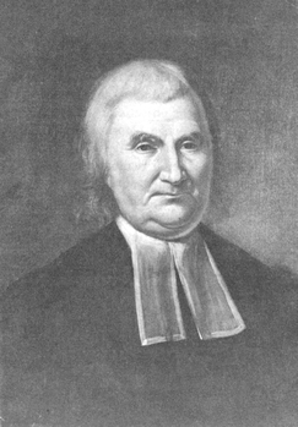John Witherspoon
DAR Ancestor Number: A127172
Service: Signer of the Declaration of Independence/
Patriotic Service, NJ
Residence: Somerset Co., NJ
Birth: 15 Feb 1723, Gifford East, Lothian, Scotland
Married: 1st Elizabeth Montgomery
2nd Anne Marshall Dill
Death: 15 Nov 1794, Tusculum, Somerset Co., NJ
Burial: Presidents’ Lot, Princeton Cemetery, NJ
Proven children: Anne, David, Marianne
John Witherspoon's Biography
This biography is taken from the book titled, “The Signers of the Declaration of Independence” written by Robert G. Ferris.[1] Other additions are footnoted accordingly.
Rev. John Witherspoon, the only active clergyman among the signers, achieved a greater reputation as a religious leader and educator than as a politician. Emigrating from Scotland to America in the midst of the controversy between the Colonies and the Crown, he took part in the Revolution, lost a son during the war, and signed the Articles of Confederation as well as the Declaration. He is better known, however, for his role in the growth of the Presbyterian Church and for his distinguished presidency of the College of New Jersey, later known as Princeton University.
The son of a Calvinist minister, Witherspoon was born in 1723 at the village of Gifford, near Edinburgh. He attended grammar school at the neighboring town of Haddington and won master of arts (1739) and divinity (1743) degrees from the University of Edinburgh. On 14 Aug 1748, he married Elizabeth Montgomery b. 1721, d. 1 Oct 1789.[2] He had ten children with Elizabeth and only five survived childhood. The following are two proven descendants with NSDAR: Anne b. 23 Jul 1749, d. 1 Apr 1817, m. Samuel Stanhope Smith; David b. 22 Sep 1760, d. a. Dec 1801, m. Mary Jones Nash.[3]
In 1768 Witherspoon gave up his post at Paisley in Scotland and accepted the presidency of the College of New Jersey after two representatives of the college had visited him in Scotland and finally at the end of two years of effort overcome the objections of his wife. He sailed to America with his family.
The college bloomed under his direction. He increased the endowment, instituted new methods of instruction, and broadened and revitalized the curriculum. Continuing also as a minister and church leader, he patched up a major schism in the Presbyterian Church; stimulated its expansion, especially in the Middle Colonies; and worked closely with the Congregationalists. Rev. John Witherspoon served as its president from 1768 until 1794.
The Revolution fanned Witherspoon’s hatred of the English, which had originated in Scotland. By 1770 his students were openly demonstrating in favor of the patriot cause. In a commencement oration he advocated resistance to the Crown, which became his favorite theme in sermons and essays. In 1774–1776 he represented his county in the New Jersey provincial assemblies, and sat on local committees of correspondence. In the latter year he figured prominently in the agitations that led to the removal from office and imprisonment of the Royal Governor, and then received an appointment to the Continental Congress.
On July 2, 1776, in a congressional speech urging independence, Witherspoon declared that the Colonies were “not only ripe for the measure but in danger of rotting for the want of it.” In November, when the British invaded New Jersey, he closed the College of New Jersey. The redcoats occupied its major building, Nassau Hall, burned the library, and committed other acts of destruction. The next year, Witherspoon’s son James lost his life at the Battle of Germantown, PA.
Witherspoon stayed in Congress until 1782. His main committee assignments dealt with military and foreign affairs. He also participated in the debates on the Articles of Confederation, aided in setting up the executive departments, and argued for financial stability. In 1779 he moved from the President’s House at Princeton to Tusculum, a country home he had earlier built nearby. He left the Rev. Samuel S. Smith, his son-in-law and the college vice president, in charge of the nearly defunct institution.
Witherspoon devoted most of his effort during the postwar years to rebuilding the college, which never fully recovered its prewar prosperity during his lifetime. During 1783–1789 he sat for two terms in the State legislature, attended the New Jersey convention in 1787 that ratified the Federal Constitution, participated in the reorganization of the Presbyterian Church, and moderated its first general assembly in 1789.
On 11 Jun 1791, at the age of sixty-eight, Witherspoon married his second wife, Anne Marshall Dill b. 26 Jan 1768, d. 29 Nov 1811,[4] a widow, age twenty-four, who bore him two daughters. Marianne b. 13 Apr 1794, d. 10 Jul 1846, m. James Stervet Woods is a proven daughter with NSDAR.[5] Blind his last two years, John died in 1794, aged seventy-one, at Tusculum. His remains rest in the Presidents’ Lot at Princeton Cemetery.
On 10 Apr 1891 Susan Witherspoon McDowell was the first woman to prove her lineage to her great-great-grandfather John Witherspoon. As of March 2022, fifty-four women globally have proven they are a descendant of John Witherspoon.
[1] Robert G. Ferris and Richard G. Morris, The Signers of the Declaration of Independence, Arlington, VA: Interpretive Publications, 1982, p. 150, 151.
[2] NSDAR Genealogical Research Database Patriot # A127172.
[3] Ibid.
[4] NSDAR Genealogical Research Database Patriot # A127172.
[5] Ibid.

